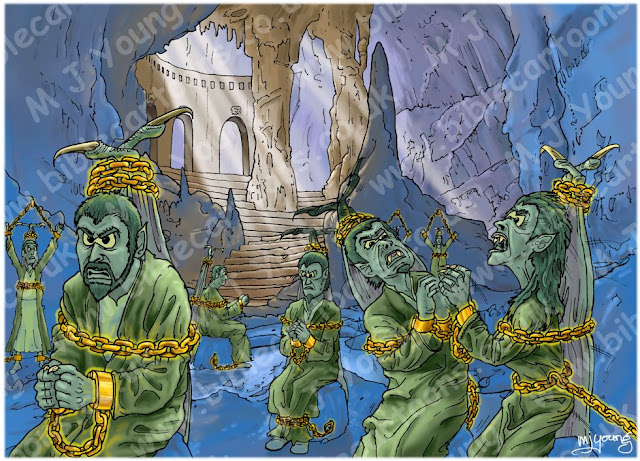Why Did Jesus Surround Himself With a Bunch of Ordinary Tradesmen?
The middle section of the third chapter of Mark describes the calling of Jesus' twelve disciples. A disciple, as defined by Webster's dictionary, is "a pupil or follower of any teacher or school". While Jesus had varying numbers of followers throughout his ministry, the dozen that he handpicked seemed to have a special distinction. They were his inner circle of close companions with whom he traveled, worked, slept and ate.
It seems a bit counterintuitive that a teacher and would-be religious leader and political activist would surround himself with such a blue-collar group of individuals. The disciples were for the most part uneducated, save for their trades which they likely learned from their fathers. They did not come from powerful families or places of influence or prestige.
For centuries, the coming Messiah had been prophesied as a leader of strength and authority. Genesis describes a ruler to whom all nations give deference. 2 Samuel paints a picture of a king with an unending reign. Daniel is full of imagery of a leader among the Jews who is king over all and rules the entire earth with supernatural power forever. The Jewish people of Jesus' day would have been familiar with these passages and were no doubt looking for a great military mind to lead a rebellion against Rome. As the companion of fishermen and tax-collectors, Jesus did not fit the Jewish profile of Messiah.
It seems a bit counterintuitive that a teacher and would-be religious leader and political activist would surround himself with such a blue-collar group of individuals. The disciples were for the most part uneducated, save for their trades which they likely learned from their fathers. They did not come from powerful families or places of influence or prestige.
For centuries, the coming Messiah had been prophesied as a leader of strength and authority. Genesis describes a ruler to whom all nations give deference. 2 Samuel paints a picture of a king with an unending reign. Daniel is full of imagery of a leader among the Jews who is king over all and rules the entire earth with supernatural power forever. The Jewish people of Jesus' day would have been familiar with these passages and were no doubt looking for a great military mind to lead a rebellion against Rome. As the companion of fishermen and tax-collectors, Jesus did not fit the Jewish profile of Messiah.
It is important then to note that, while Mark was a Jewish man, he was not writing to a Jewish audience. His post-war audience would have been primarily Romans. Throughout his second-hand account of the gospel, Mark presented Jesus as a secretive and mysterious miracle worker. Even when Mark does include Jesus' teachings, they are veiled in parables with hidden meanings. Mark's motif of the Messianic Secret could offer one explanation for why a man attempting a religious revolution would chose unlearned men as his right-hand support group and co-teachers.
The writer states in Mark 4:33-34 that even the disciples did not understand the meanings of the parables. As ordinary laborers and tradesmen, they would not have had much educational background in scripture besides temple readings and oral tradition. When asked to explain the meanings of the parables, Jesus took the disciples aside, away from the crowds to impart his knowledge to his intimate inner circle. This image of a mystical teacher who possessed not only miraculous healing powers but deep, profound knowledge would have been very appealing to a Roman audience.
Mark makes a point to show that, while there was a lot of mystery surrounding the person of Jesus, the deeper lessons were shared with the people closest to him, even though they were not scholars or priests. This message would have been a relief to new Roman converts or those seeking to understand the emerging religion of Christianity. It also would have presented an intriguing narrative. Mark's introduction of Jesus as a man of mystery whose mission was not understood even by the people closest to him would have been of interest to an audience accustomed to gods and goddesses who acted without explanation or reason.
The writer of this gospel presents Jesus as an embodiment of a god who could do great signs and wonders, yet whose secret knowledge would be made available to anyone willing to listen and apply some critical thought. The men with whom Jesus chose to surround himself represented the idea of Every Man. They were physical symbols of the group he sought to reach and convince of Jesus' identity as Messiah, not just to the Jews, but all people. Mark sells the idea that unlike the Roman gods and goddesses, Jesus as God would reveal his secrets to those who believed and diligently sought his knowledge.
Mark uses the act of the disciples asking for an explanation of the parables as an opportunity to show not only the intriguing mystique of the person of Jesus, but also his willingness to open up the deeper secrets of his teachings. Mark could have left out the explanation of the parables, but he chose instead to reveal the hidden meanings of the stories to those reading the text. He includes the spoon-fed explanation of the parable of the sower as if to say, "This is the kind of mystical knowledge that even the average person can access through Jesus." Such a message would have certainly struck a chord with his audience of Roman converts.




Comments
Post a Comment